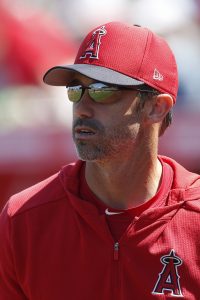The 2019 season, in many ways, was a pleasant surprise for the Rangers. While the season’s second half was forgettable in terms of the club’s record, the Rangers saw some individual performances that offered encouragement heading into 2020. Mike Minor and Lance Lynn had impressive seasons while pitching on affordable contracts. Joey Gallo proved himself capable of handling an outfield spot — perhaps even center field. Willie Calhoun rebounded and looks like a quality bat moving forward. Minor league pickups Danny Santana and Hunter Pence enjoyed terrific seasons, and Santana can be controlled through 2021. One of the prior offseason’s bargain pickups, Chris Martin, was flipped to the Braves for a potential long-term option in the rotation (Kolby Allard).
At the same time, one can’t ignore the team’s second-half slide or the ugly seasons turned in by a number of players the organization once tabbed as building blocks. Elvis Andrus and, in particular, Rougned Odor had poor seasons. Ronald Guzman didn’t step up and seize the team’s first base job. Most of the team’s fliers on low-cost pitching acquisitions (e.g. Shelby Miller, Drew Smyly, Edinson Volquez) failed to pan out, and the farm system didn’t yield better alternatives. For all the bright spots, the Rangers have clear areas in which they need to improve.
That was a focal point for president of baseball operations Jon Daniels in meeting with the media in today’s postmortem press conference (link via Jeff Wilson of the Fort Worth Star-Telegram). The season offered some undeniable bright spots, but the club also has a “clear opportunity” for some upgrades at third base, first base and in the rotation, Daniels said. Of the team’s needs, third base and the rotation standing out as “probably the top two on the list,” Daniels said before also citing catcher and the bullpen as positions that could at least use some depth additions.
Third base indeed seems like a prime spot for the Rangers to pursue upgrades; Texas third basemen hit .243/.310/.389 this season, which, when accounting for their hitter-friendly home park, translates to a paltry 76 wRC+ — or 24 percent worse than a league-average hitter. Deadline pickup Nick Solak could be an intriguing option, but there are questions about his glovework and he’s tallied just 135 plate appearances in the Majors.
In the rotation, the Rangers don’t have much in the way of options beyond Minor, Lynn and Allard. Adrian Sampson and Ariel Jurado scarcely kept their ERAs under 6.00, and many of the team’s top pitching prospects have battled injuries. That trend, in fact, will continue to a minor extent with top pitching prospect Hans Crouse undergoing surgery to remove a bone spur from his pitching elbow (Twitter link via Evan Grant of the Dallas Morning News). Crouse isn’t expected to have his 2020 availability impacted, and he won’t be an option given that he’s yet to pitch in Double-A. But the team’s general lack of upper-level pitching depth should force them into pursuing some rotation additions in free agency and/or trade.
The extent to which the Rangers can look for reinforcements in free agency will be determined by how much ownership allows Daniels & Co. to spend this winter. While there’s no specific budget in place, Daniels made clear that he’ll have more resources at his disposal this winter. “Our major-league payroll will be up from where it was this year,” said Daniels, adding that he hasn’t been given a firm number to beyond that but more of a “general range.”
The Texas organization spent much of the 2018-19 offseason working to cut payroll and managed to dip its Opening Day mark to a bit more than $118MM — the lowest point since way back in 2011. The Rangers’ high-water mark for payroll came with 2017’s Opening Day mark of $165MM. A return to those heights can’t be assumed, but that probably provides a rough idea of a ceiling (even if it’s safer to assume a more modest total).
Whatever the number, the Rangers should have the freedom to try to pursue a wide number of free agents. If Gerrit Cole and Anthony Rendon are deemed too expensive, the market will bear some high-caliber fallbacks in the form of Madison Bumgarner, Zack Wheeler and Josh Donaldson. Texas could certainly backload any free-agent additions such that the salary escalates more aggressively in 2021 when Shin-Soo Choo, Minor, Jesse Chavez and Jeff Mathis are off the books.
Alternatively, trading from their surplus of left-handed-hitting corner outfielders could free up some additional space. Daniels acknowledged as much in candid fashion, stating that “when everyone’s healthy we have more left-handed-hitting corner guys than we have spots.” He cautioned that a trade isn’t a foregone conclusion but is also something he’ll have to explore.
Surely, the Rangers would be loath to move either Gallo or Calhoun, but Choo and his $21MM salary or the perennially underwhelming Mazara (.268/.318/.469, 94 wRC+ in 2019) could make sense. Choo is overpaid, to be sure, but he still posted a .265/.371/.455 line with 24 home runs in 660 plate appearances. Mazara, meanwhile, has never delivered on his premium prospect pedigree but still won’t turn 25 until next April despite having four years of MLB service. Other teams will quite likely view him as a buy-low candidate given that pedigree, his modest salary — he’ll earn a raise on this year’s $3.3MM price — and the fact that he’s controlled through 2021.
It’s also worth noting that at a time of year that is frequently punctuated by turnover in the coaching department, the Rangers won’t be making any changes. MLB.com’s T.R. Sullivan tweets that Daniels has invited all of manager Chris Woodward’s coaching staff back for the 2020 season. So while the composition of the Rangers’ roster will quite likely look quite a bit different in 2020, the group guiding that roster should be a source of stability.

